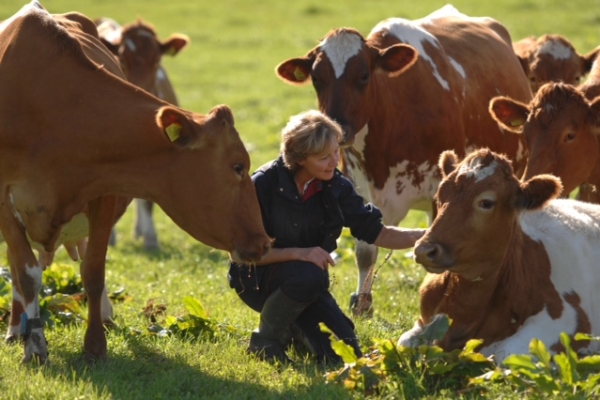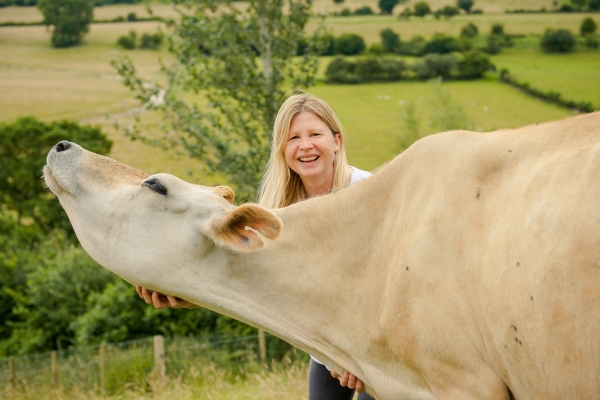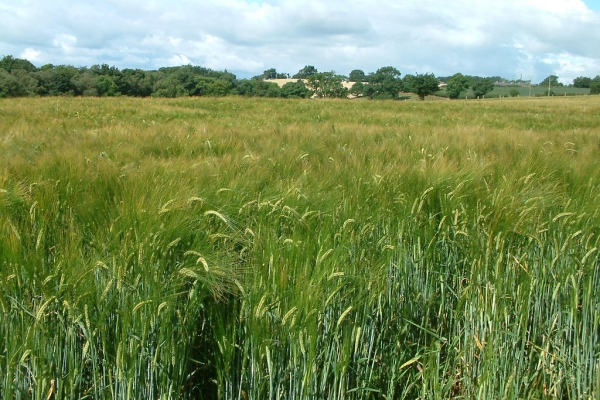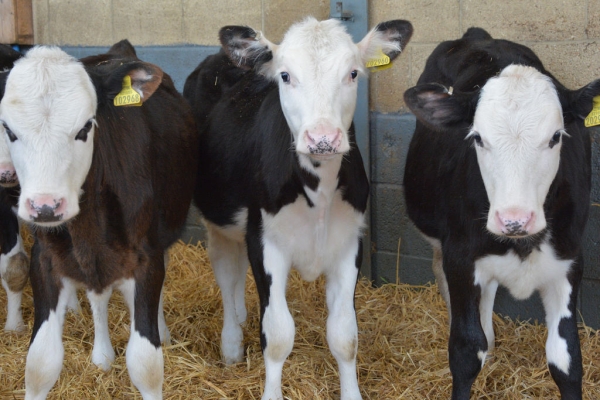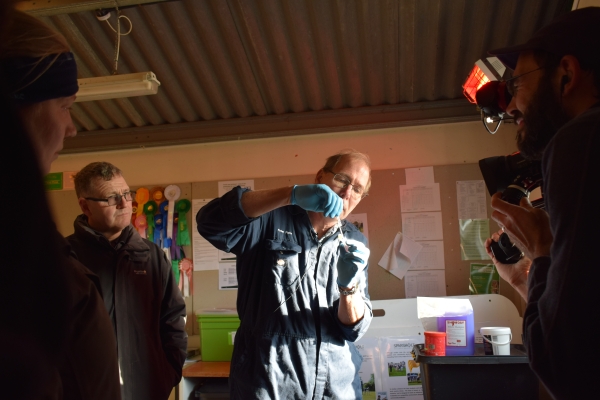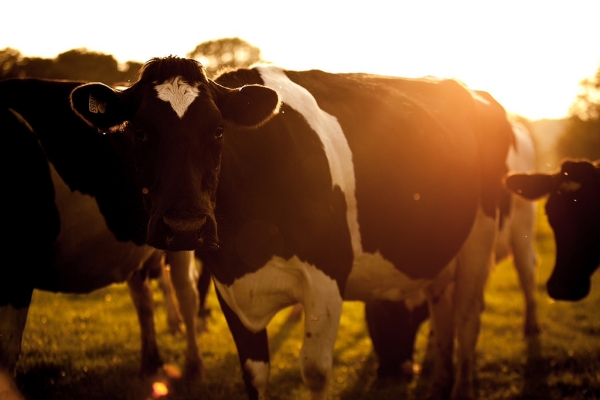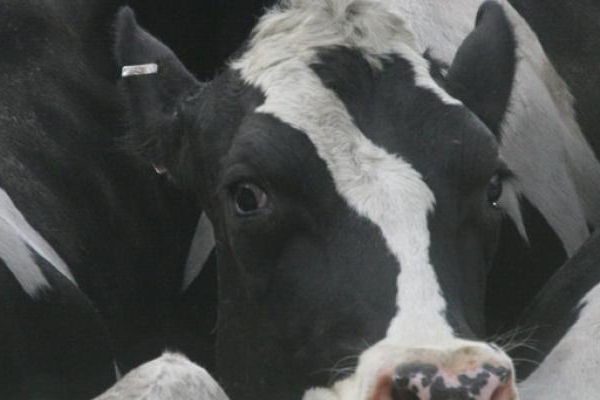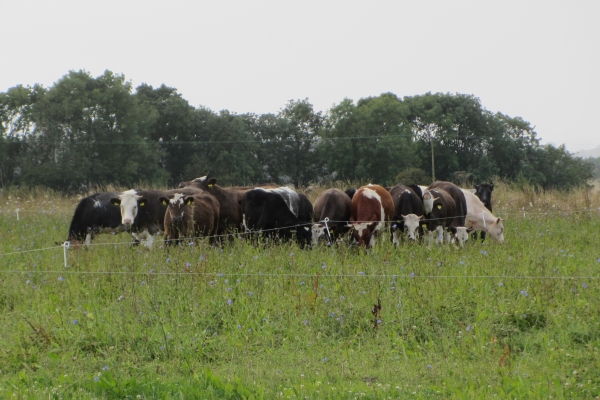David Finlay
Rainton Farm
We have 100 crossbred dairy cows (Swedish Red x Montbeliard x Holstein) producing 6650l (4.5%Bf, 3.4% Pr. sold to OMSCo) from 1.2t purchased feeds plus home-grown forage. All calves are kept and finished or kept/sold as breeding heifers. Cast cows are made into burgers and sold at our visitor centre.
The herd is a closed herd with all breeding done using DIY AI. We are free from BVD, IBR, Lepto, TB, Johnnes and digital dermatitis. Most cases of mastitis are treated with udder mint with less than 10 cows a year treated with antibiotics. Cows are dried off using teat sealant with only one or two given antibiotic dry cow therapy. Cell counts average under 120 thousand. Mortality rate is under 2%. Replacement rate is 15%.
We have a flock of 500 breeding sheep. The replacement Scotch Mule ewe lambs are bred from our core Scottish Blackface flock. We have bought 25 Blackface ewe lambs a year from the same organic breeder for many years. The Texel cross lambs from the Mules are all finished off on grass by the end of October.
Through clean grazing practices over the past 15 years, we have eliminated the need to drench cattle for roundworm completely and lung worm most years. Ewe drenching has also ceased, and only about 10% of lambs require a single drench and 5% a double (determined by worm egg counts). Liver fluke, however, is an intermittent nightmare. We stopped using vaccines on the farm completely 12 years ago.
Twenty-two years ago we diversified into ice-cream manufacture and have since been selling it from Shetland to Southampton, as far afield as Estonia and even South Korea. At the same time we opened a small visitor attraction and tearoom, which has grown from 6,000 to 75,000 visitors a year. This now acts as our ‘shop window.’ The impact of the 2008 recession on the market for organics, luxury foods and tourism, especially in the more remote areas, has been ‘interesting’, but not in a good way.
Sustainability in practice
One of the components of our food system is an experimental, single-stage, micro anaerobic digester that we commissioned in autumn 2013.

Basically we collect all the organic waste on the farm, add it to the slurry and pump it into a sealed store from which we collect the methane emissions and burn them; either in a gas-fired boiler to raise hot water or in an engine that turns a small, 25kWe, turbine. This generates more than enough electricity to run the farm.
The product of the digester (digestate) is a more effective and less polluting fertiliser than the raw slurry, and it does not smell!
At a stroke we have reduced our CO2e emissions by 30%, our negative impact on soil invertebrates, our dependence on purchased feed, fuel and fertilisers (we don’t buy soluble fertilisers, but if we did…), the carry-over of weed seeds in the slurry and, most importantly, removed complaints about the smell of raw slurry.
About 7 or 8 years ago we read about the benefits of anaerobic digestion (AD), made enquiries with the industry and were told that, to be viable, the unit had to be capable of running a 150kWe generator. This would require about a million quid, a herd of 300 plus cows, 2,000t of maize silage and a stand-by engineer – the German model. It seems this is still their mantra.
Eventually we talked to a small Shropshire-based company who offered to design something to my specification; cheap, farmer-friendly and using only farm wastes. With their guidance and assistance we sourced the components and built the 25kWe AD unit for £210,000, including the 2,000t store.
Then there was the engine that drives the generator; the CHP unit. We bought one from a one-man-band importing them from China. There was only one other company even offering to supply micro generators at that time – at twice the price. So it was a no brainer, I thought.
The unit eventually arrived, after a nervous wait (50% up front and 40% pre-delivery) and the guy visited a couple of times to commission, then disappeared. After a few months we made enquiries and were told his company had been liquidated. So we had the unit and £2,000 (the remaining 10%) to find out how it worked, but few instructions. With the help of a techie friend and the local garage we got it up and running for the spring of 2015. In the meantime we’d burned the gas in the stand-by boiler to raise hot water for the dairy and the AD. So all was not lost. I should mention at this point that we were not eligible for FITs or ROCs since we’d had a capital grant of 50%. So the pressure to generate was more one of saving face than financial.
On the more positive side, we were part of a Duchy Future Farming Programme Field Lab looking at digestate and got excellent advice on how to maximise its benefits. Our policy with raw slurry had been to apply by tanker splash-plate in March. However this was no use for digestate, which required careful handling to maximise the benefit; an umbilical system to minimise compaction, slurry placement to minimise aerosol losses, and mid-April application to maximise utilisation. This produced a yield enhancement average of almost 20% for 2014 and 2015. Not only that, but the fields used to be covered in birds eating the invertebrates post slurry application, but after the digestate was applied there was hardly a bird to be seen!
In hindsight, my advice to farmers would be to be sure you know what you want from your AD system. Are you a food producer or a generator? It’s not easy to be both. Don’t take the industry’s version as gospel – they have an agenda. Talk to farmers who’ve got AD and find a supplier who can demonstrably give good after-sales support.
Motivations
“Man is but a thread in the great web of life. If man spits on the ground, he spits on himself.” Chief Seattle, 1854
After gaining a BSc in agriculture at Aberdeen I was employed as an agricultural consultant by SAC Consulting for 10 years, before returning to the family farm in Galloway, SW Scotland, 27 years ago.
Having been an integral part of the drive to agricultural intensification, both in consultancy and in practice, I have become increasingly disillusioned by the impacts this approach is having on the environment, the animals and the people involved.
I enjoy studying situations, identifying the challenges ahead, drawing up a plan to address those challenges and implementing it. It doesn’t always work out but I am prepared to take the risk.
Over the past 10 years we have been developing elements of a food production model on the farm that attempts to address, to a large degree, the challenges of sustainable food production from a dairy-based system.
The model uses a novel mix of agroecology, agroforestry and agro-technology approaches that cut waste, facilitate natural processes and reduce our dependence on external inputs, following the principles of ‘lean production’.
Each aspect of the model has been carefully thought through, tested and implemented. Independent assessments of the likely outcomes have been made by SNH, SAC Consulting and SRUC, with encouraging results. It may be quite possible to produce adequate amounts of safe, affordable food without trashing the environment or subjecting people and animals to barely tolerable conditions.
The final parts of the model will be implemented over the coming year, in partnership with a sponsoring charity, and could be ‘market-ready’ within 3 years. The outcomes of the whole-farm model will be measured to provide independent verification of our sustainability claims by a research consultancy who hope to use the data to advise customers on sustainable livestock systems.
These final elements entail the delayed weaning of calves for 5-6 months (which we trialed 3 years ago), once-a-day milking, and the expansion of our new co-operative, cheese-making enterprise that will connect our farming system directly to our supporters, customers and investors.
Though it has been a long, often tough, roller-coaster ride I’m delighted that our health and energy still allow us to relish the next part of a fascinating journey.
You can find out more about the farm and farm business by reading their blog and following on social media.



